Potatoes With Mosaic Virus: How To Manage Mosaic Virus Of Potatoes

Potatoes may be infected with many different viruses that can reduce tuber quality and yield. Mosaic virus of potatoes is one such disease that actually has multiple strains. Potato mosaic virus is divided into three categories. Symptoms of the different mosaic virus of potatoes may be similar, so the actual type usually can’t be identified by symptoms alone and is often just referred to as mosaic virus in potatoes. Still, it is important to be able to recognize the signs of potato mosaic and learn how to treat potatoes with mosaic virus.
Types of Potato Mosaic Virus
As mentioned, there are different mosaic viruses that afflict potatoes, each with similar symptoms. Positive identification requires the use of indicator plant or laboratory examination. With that in mind, diagnosis can be made by mosaic patterns on foliage, stunting, leaf deformities, and tuber malformations. The three types of recognized mosaic virus in potatoes are Latent (Potato virus X), Mild (Potato virus A), Rugose or Common mosaic (Potato virus Y).
Signs of Potato Mosaic
Latent mosaic, or Potato virus X, may produce no visible symptoms depending upon the strain but yields of infected tubers may be reduced. Other strains of Latent mosaic show light leaf crinkling. When combined with Potato virus A or Y, crinkling or browning of leaves may also be present. In an infection of Potato virus, A (mild mosaic), the plants have light crinkling, as well as mild yellow mottling. Leaf margins may be wavy and appear rough with sunken veins. Severity of symptoms depends on the strain, cultivar and weather conditions. Potato virus Y (Rugose mosaic) is the most severe of the viruses. Signs include mottling or yellowing of leaflets and crinkling that is sometimes accompanied by leaf drop. Underside leaf veins often have necrotic areas showing as black streaking. Plants may be stunted. High temperatures exacerbate the severity of the symptoms. Again, symptoms vary hugely with both potato cultivar and virus strain.
Managing Potatoes with Mosaic Virus
Potato virus X can be found in all varieties of potato unless certified virus free tubers are used. This virus is spread mechanically by machinery, irrigation equipment, root to root or sprout to sprout contact, and via other gardening tools. Both viruses A and Y are carried in tubers but are also transmitted by several species of aphids. All of these viruses overwinter in potato tubers. There is no method for eradication of the disease once the plant is infected. It should be removed and destroyed. To prevent infection, use only seed certified free from viruses or that have low incidence of infected tubers. Always keep garden tools as clean as possible, practice crop rotation, keep the area around the plants weed free, and control aphids.
Gardening tips, videos, info and more delivered right to your inbox!
Sign up for the Gardening Know How newsletter today and receive a free copy of our e-book "How to Grow Delicious Tomatoes".

Amy Grant has been gardening for 30 years and writing for 15. A professional chef and caterer, Amy's area of expertise is culinary gardening.
-
 Types Of Tomatoes Explained: Explore The Many Wonderful Shapes, Colors, Flavors, & Best Uses
Types Of Tomatoes Explained: Explore The Many Wonderful Shapes, Colors, Flavors, & Best UsesThe world of tomato varieties is vast and fascinating. Learn about the key types to grow in your garden, tailored to your preferences and space.
By Amy Grant
-
 Try The Trend – Turn Any Bed Into A Keyhole Garden With This Clever In-Ground Composter
Try The Trend – Turn Any Bed Into A Keyhole Garden With This Clever In-Ground ComposterKeyhole gardening is an efficient and sustainable practice that saves space. Get started on this DIY project quickly and easily with an in-ground composter.
By Bonnie L. Grant